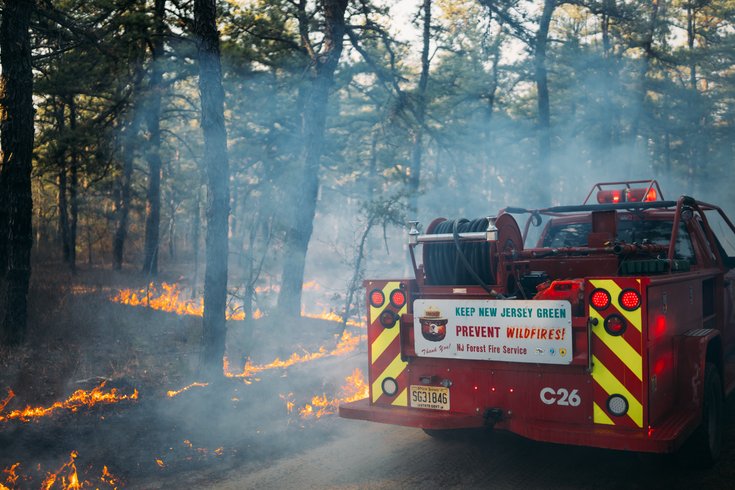
April 03, 2025
 Provided Image/NJDEP
Provided Image/NJDEP
More than 2,000 acres burned last month in the Pine Barrens, where the New Jersey Forest Fire Service battled the California Branch Fire pictured above on March 22. The fire-prone forest in South Jersey could see an active wildfire season this year due to the effects of the state's ongoing drought.
Months of drought conditions that haven't let up in New Jersey could be a recipe for one of the state's most intense wildfire seasons this spring.
For weeks, New Jersey officials have been warning about the destructive start to the year as the state enters its peak wildfire season in April and May. More than 1,200 acres of forest burned during the first three months of the year, an increase of 266% compared with the same period in 2024.
MORE: Tiger Woods' foundation opens science education center at Cobbs Creek Golf Club
"What we're already seeing is that fire behavior is not acting as we would expect it to act at this time of year," said Jeremy Webber, supervising fire warden for the New Jersey Forest Fire Service.
The Pinelands National Reserve, which covers more than a million acres in South Jersey, is the most susceptible area in the state to wildfires. Much of the 12,000 acres destroyed last year in New Jersey were in the territory of the Pine Barrens, including in Wharton State Forest, where campsites were evacuated last month during a blaze that engulfed more than 2,200 acres before it was contained.
"Thousands of years of fires in this area shaped the flora to have a lot of fire-adapted species that have fire-promoting characteristics," Matthew Olson, assistant professor of environmental studies at Stockton University, said of the Pinelands' ecosystem.
Olson's research at Stockton looks at how forest vegetation responds to both wildfires and prescribed burns, which benefit the land by promoting regrowth of younger patches of forest. But the advantages have to be weighed against the scale and pace of wildfires that can threaten communities if left uncontrolled.
Pitch pines, the most abundant tree species in the Pine Barrens, evolved to depend on fire to regenerate across areas repeatedly decimated by flames. The pines grow from sandy, porous soils that don't hold much water or yield many nutrients, and they tend to create sparser tree canopies compared to other forests.
Olson said the prolonged drought in New Jersey heightens the Pine Barrens's tendency to invite fire.
"Since things have been so bone dry, we're going into the peak season with fuels that are really set to go," Olson said. "Our landscapes are just very flammable right now, and I don't think I've seen a stretch this windy in a long time."
Last September and October were the driest New Jersey has ever recorded for those two months, when an average of less than an inch of rain fell statewide. Wildfires followed in November, consuming hundreds of acres in South Jersey.
Despite several snowstorms hitting the region this winter, snow precipitation in the Pine Barrens usually evaporates before it enters the ground enough to mitigate fire risks.
"The real concern for us is that we're not quite where we want to be with our soil moistures," Webber said. "If we don't get significant recharge into this groundwater table, as these trees start to take that water from the soil, they're drawing moisture and it creates a dryer atmosphere for these fires."
The U.S. Drought Monitor still shows parts of Cumberland, Cape May, Atlantic and Gloucester counties in an extreme drought. Nearly all of South Jersey remains in a severe drought.
Webber called the lack of precipitation especially jarring because the first half of last year had plenty of rainfall.
"It was huge rains — 4 or 5 inches at a time. Then in August, it was like the spigot turned off and we went from one extreme to another," he said. "With climate change, I think that's what you can expect. You see extremes. We're seeing it for a couple years now, these dry periods and wet periods."
Meteorologist Brad Rippey, who helps oversee the U.S. Drought Monitor with the U.S. Department of Agriculture, said the rain deficit in New Jersey is partly explained by the atmospheric effects of La Niña that keep many storm-producing cold fronts from "performing well" after they cross the Appalachian Mountains.
The U.S. Drought Monitor's latest wildfire outlook offers cautious optimism for New Jersey, where drought conditions are expected to improve through the end of June. Still, inland areas like the Pinelands are likely to have heightened risk of wildfires, Rippey said.
The Pine Barrens historically have not had wildfires threaten as many lives or as much property as those that ravaged Los Angeles in January, but Webber said it's important for the public to remember that the vast majority of these events are caused inadvertently by human activity.
"The vigilance of the public, making sure they're taking caution not to have careless ignitions on the landscape, is really going to be the primary driving force of what could happen out there," Webber said.